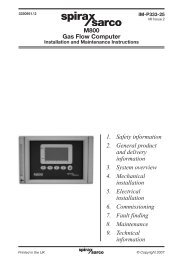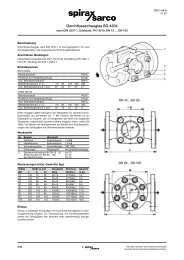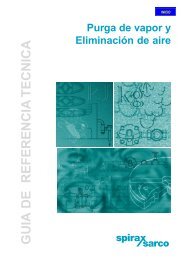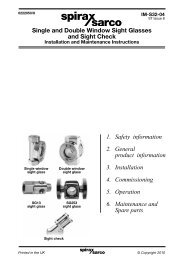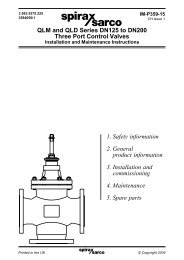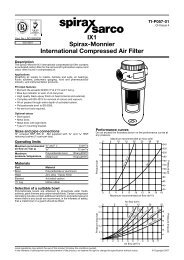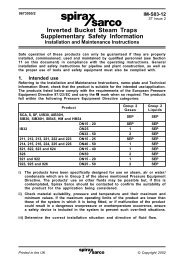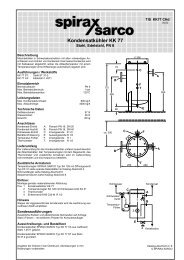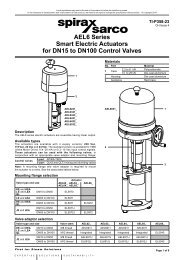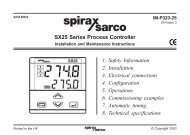2000 Hook-up Book - Spirax Sarco
2000 Hook-up Book - Spirax Sarco
2000 Hook-up Book - Spirax Sarco
Create successful ePaper yourself
Turn your PDF publications into a flip-book with our unique Google optimized e-Paper software.
Drainer Installation<br />
Automatic drainers are needed at<br />
any absorption or refrigerant<br />
dryer, and any separator which is<br />
instaled in the air line from the<br />
aftercooler, or at the entry to a<br />
building. They are also needed at<br />
the low points in the distribution<br />
lines. (Fig. 64)<br />
Unless fitted close to the<br />
points being drained, and on light<br />
loads, drainers often need a balance<br />
line to allow air to be<br />
displaced from the piping or the<br />
drainer body as water runs in. The<br />
balance line is connected above<br />
the drain point, and should not be<br />
<strong>up</strong>stream of it. See Fig. II-115<br />
(page 140).<br />
Compressor<br />
Cooling<br />
Water Control<br />
Water Cooled<br />
Aftercooler<br />
Liquid<br />
Drain<br />
Trap<br />
Safety<br />
Valve<br />
Strainer<br />
Instrumentation<br />
and Control<br />
System<br />
Drain<br />
Trap<br />
Drain<br />
Trap<br />
Receiver<br />
Pressure<br />
Gauge<br />
Separator<br />
Distribution Lines<br />
These form the all important link<br />
between the compressor and the<br />
points of usage. If they are undersized,<br />
the desired air flow will be<br />
accompanied by a high pressure<br />
drop. This necessitates extra<br />
power input at the compressor.<br />
For example, a pressure at the<br />
compressor of 120 psi where a<br />
pressure of 100 psi would have<br />
sufficed without a high pressure<br />
drop in the lines, needs an additional<br />
power input of 10%.<br />
The correct size of compressed<br />
air lines can be selected<br />
by using Fig. 66 on page 66.<br />
Example: 1,000 cu. ft. of free air<br />
per minute is to be transmitted at<br />
100 PSIG pressure through a 4”<br />
line standard weight pipe. What<br />
will be the pressure drop due to<br />
friction?<br />
Air<br />
Operated<br />
Hoist<br />
Line Separator<br />
Drain Trap<br />
Drain<br />
Trap<br />
Air<br />
Gauging<br />
Spray<br />
Gun<br />
Compressed Air Systems<br />
Drain Traps<br />
1. Enter the chart at the top at<br />
the point representing 100<br />
psig pressure.<br />
2. Proceed vertically downward<br />
to the intersection with horizontal<br />
line representing 1,000<br />
CFM.<br />
3. Next proceed parallel to the<br />
diagonal guide lines to the<br />
right (or left) to the intersection<br />
with the horizontal line<br />
representing a 4" line.<br />
4. Proceed vertically downward<br />
to the pressure loss scale at<br />
the bottom of the chart. You<br />
will note that the pressure<br />
loss would be 0.225 psi per<br />
100 ft. of pipe.<br />
It is usual to size compressed<br />
air lines on velocity, while keeping<br />
a watchful eye on pressure drop.<br />
Pneumatic<br />
Tool<br />
Figure 64<br />
Compressed Air System<br />
Machine Tool<br />
Air Bearing<br />
Breathing<br />
Mask<br />
Drain<br />
Trap<br />
63<br />
SYSTEM DESIGN



